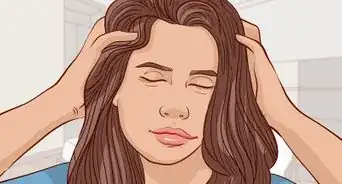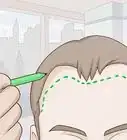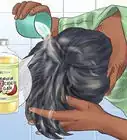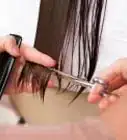This article was co-authored by Jasmin Todd. Jasmin Todd is a Curly Hair Specialist and the Owner of Austin Curls in Austin, TX. With over 20 years of experience, she specializes in cutting and styling naturally curly hair. Jasmin trained at the world-famous Ouidad salon and is Ouidad certified. In 2022, Mane Addicts named Austin Curls as one of the Top U.S. Salons for Curly Hair.
This article has been viewed 193,797 times.
If you or your child has dense, curly hair, you may struggle to maintain it. Although there isn't a single method for all hair types, there are certain steps you can take to care for your thick curls and keep them looking healthy.
Steps
Selecting a Shampoo and a Conditioner
-
1Use a mild, moisturizing shampoo. Though dense, curly hair can vary from individual to individual, in general, a mild, moisturizing shampoo is best. Look for a shampoo with a balanced pH value of 5, which will help to maintain your hair’s natural pH level and keep it healthy. Look for the following ingredients in your shampoo:
- Water
- Lauroamphoglycinate, a moisturizer
- Cocoamphacarboxyglycinate, a moisturizer
- Sulfosuccinate, a mild cleanser
- A list of recommended shampoos for thick, curly hair can be found online. Products that are water soluble are usually the best, since they rinse away without build up. This way, none of the ingredients stay on your hair and scalp after a rinse and or shampooing.
-
2Avoid shampoos that contain drying ingredients. Many products in commercial shampoos can strip your hair of its natural oils and be detrimental. Read the ingredients list on shampoos and avoid products that contain the following ingredients:
- Isopropyl alcohol
- Mineral oil/ petrolatum
- Polyethylene glycol (PEG)
- Propylene glycol (PG)
- Sodium Lauryl Sulfate (SLS)/ Sodium Laureth Sulfate (SLES)
Advertisement -
3Go for an instant conditioner if you have thick, curly hair. An instant conditioner will coat the strands of your hair and give it body as well as shine. It will also flatten the raised cuticles in your hair, making it soft and easy to style, and protect your hair from damage.
- Look for instant conditioners that contain a combination of lanolin, cholesterol, sulfonated oil, vegetable oil, proteins and polymers.
- You can find instant conditioner that are “rinse out” or “leave in”. You can try both on your hair or your child’s hair to determine which type will work best for you. Leave-in conditioner can be beneficial for hair that is going to be combed out or blow dried. However, if you have curly hair that has a finer texture, leave-in conditioner may leave a film or residue on your hair.
-
4Try a penetrating conditioner if you have damaged hair or a dry scalp. A penetrating conditioner is a deep conditioner that will absorb right into your hair and improve the appearance of damaged hair. This type of conditioner is good if you have split ends, uneven hair growth, hair that is dyed or colored, or hair that has been exposed to chlorine. It’s also good for a dry scalp.
- Many penetrating conditioners are made from animal proteins and keratin. You should allow this type of conditioner to stay in your hair for 15 minutes before rinsing it out.
- You can use a penetrating conditioner once a month if you do not have damaged hair but are looking to moisturize your hair every now and then.
- Shampoos and conditioners that help block humidity can help fight the culprits that encourage frizz, which are dehydrated curls and thick curly hair depleted of proteins.
Shampooing and Conditioning Your Hair
-
1Wash your hair every seven to ten days. Overwashing your hair can lead to dryness, brittleness, and damage. You can use other products to style and maintain your hair between washing so it remains healthy-looking and clean without daily shampooing.[1]
- If you workout every day or sweat often, you can rinse your hair out with water. Avoid shampooing your hair too often, as it can dry out and damage your hair.
- To wash your child’s hair, have them kneel in a chair and bend over the sink or under the faucet in a bathtub. If you are washing your own hair, you should position yourself over a sink with the shampoo next to you. As well, a removable spray nozzle or a detachable showerhead can make the shampooing process easier.
- After rinsing your hair, you can condition the hair to detangle the curls before restyling.
-
2Use about 1 tablespoon of shampoo. Massage the shampoo into the child’s hair. Use the ball of your fingertips, not your nails, to gently massage her scalp with in and out motions. Move your fingers from her hairline and the nape of her neck toward the center of her scalp.
- If the child has tightly curled hair, avoid gathering her hair into a pile at the top of her head, as this can lead to tangles. Instead, work from the hairline and massage her scalp, letting her hair fall naturally.
- If the child has thicker hair, you may need to apply and rinse out the shampoo two to three times. You can do one to two minute rinses in between the shampooing. It can also help to wash thicker hair in sections, pinning back each section and washing one section at a time.
-
3Condition your hair right after you shampoo it. Conditioner is a key step to caring for dense, curly hair as it can help to smooth your cuticles and keep your hair feeling soft and clean. You should always apply a conditioner after shampooing.
- Squeeze all excess water from your hair before conditioning it. Divide the hair into sections and put a handful of conditioner in the palm of your hand. Massage the conditioner using your finger pads. You can also use a wide-tooth comb to work the conditioner into your hair.
- Work the conditioner through the ends of your hair, as the ends tend to get very dry and are prone to tangling and knotting. Rinse out the conditioner or leave it in for 15 minutes if it is a leave-in conditioner. You can skip the rinse step for leave-in conditioner if your hair is very dry and needs moisture to look good when combed or styled.
- If your hair feels very dry, you can wrap a moist warm towel or a shower cap over your hair and let the conditioner set in your hair for 15 minutes. Then, rinse it out.
-
4Dry your hair by blotting it with a towel. Avoid rubbing your hair as this can cause frizziness and breakage. Instead, blot your hair with a towel and allow your hair to air dry.[2]
- If you are planning to comb out your hair, you should do so right after you have shampooed and conditioned your hair. Combing out hair when it is wet may be easier than doing it when your hair is dry and lead to less breakage.
Styling Your Hair
-
1Create a styling tools kit. Dense, curly hair can tangle easily and be resistant to moisture, but you can still manage it at home. Make sure that you have a styling tools kit that contains several essential styling items, including:
- Combs: You should have several combs on hand, including a wide-tooth comb, which will help to detangle your hair, a rattail comb for parting hair and removing dirt or residue in your hair, and a pick with wide teeth to help comb out your hair.
- A soft or medium boar bristle brush: This type of brush is good for thick, curly hair as it will not break or damage your hair. Avoid brushes with plastic or nylon bristles.
- A spray bottle: You can fill the spray bottle with one part natural oil (such as olive oil, rosemary oil, almond oil, or lavender oil) and six parts water. You can also use a detangler spray that contains natural oils.
- A blow dryer: Use a blow dryer that has a comb attachment and/or a diffuser attachment. These attachments can help to dry your hair quickly and prevent tangles.
- Hair clips: These will come in handy when parting and dividing your hair.
- Styling gel: This can help to keep your hair in place and ensure it looks sleek and clean.
- Natural oils: Oils like sage, olive, rosemary, and almond are good for your hair and your scalp. You can apply them every time you style your hair and/or once a day.
-
2Comb out your hair after it has been washed and conditioned. Combing out your hair is one the best ways to keep your hair looking healthy and clean. It will also lead to less tangles and make it easier to maintain your hair.
- To comb out your hair, you will need a rattail comb, a wide-tooth comb, a boar-bristle brush, hair clips and hair oil.
-
3Use the rattail comb to divide your hair into four to eight sections. If you have finer hair, you may only have four to five sections. Usually, the tighter your curls are, the more sections you will have.
- Be gentle when you divide your hair and avoid digging the comb into your scalp. If there are any tangles in your hair, use your fingers to pull the strands apart.
- Once you have separated a section, twist the section into a tight twist and secure it with a clip. Then, unclip one section of hair and get your wide-tooth comb ready.
-
4Comb your hair at the ends and work your way up to the roots. Use the wide-tooth comb and work from the ends up to the roots using quick movements. Try not to comb too aggressively, as you want to avoid pulling out your hair or damaging it.
- Work one section at a time, unclipping each section and combing from the ends to the roots.
-
5Apply a small amount of oil to your scalp. Once you have combed out all the sections of your hair, apply a small amount of oil to your scalp and massage the oil into your hair. Use only natural oils and avoid heavy oils like lanolin, petroleum, and mineral oils. They will clog up your scalp and attract dust and dirt.
- You can then use the boar bristle brush to brush the oil into your hair, working section by section again. If you have very thick hair, you may skip this step to prevent your hair from getting too frizzy.
-
6Blow dry your hair for a straight hair look. Blow-drying your hair can help to straighten your hair without using harsh chemicals and make it easier to comb your hair or style it into braids. Blow-dry your hair in sections, after you have combed out your hair and added oil to your scalp.
- Use the comb attachment on the blow dryer. Blow dry in sections, drying the ends first. Once you dry the ends of a section, move up your hair and dry the hair closest to your scalp last.
Maintaining Your Hair
-
1Use natural oils on your scalp. Oiling your scalp with natural oils on a daily basis can help to keep your scalp from drying out. You should also massage your scalp on a daily basis when applying the oil to promote circulation and oil production.
- Oils like jojoba, argan, castor, and emu can all be beneficial for dense, curly hair. Shea butter is also a good oil to use.
-
2Wrap your hair in a scarf or a cap before bed. Wrapping your hair in a scarf or a hair wrap before you go to bed can help to reduce frizziness and prevent your hair from drying out. Avoid cotton scarves for best effects.
- Another option is to use satin pillowcases, as the satin can help to reduce static and frizziness in your hair.
-
3Clean your styling tools once a week. Brushes, combs, and picks can collect dirt, oils, residue, and smells. Give them a good clean at least once a week by soaking them overnight in a mixture of shampoo and warm water.
- You should also replace any brushes, combs, or picks that are missing teeth or appear damaged. This will prevent your hair from becoming damaged when you use your styling tools.
-
4Apply a clarifying shampoo every four to six weeks. A clarifying shampoo can help to remove any residue that has built up on your hair due to the use of hair products and styling products.
- You can also do a hot oil treatment on your hair once a month to help remove residue on your hair. You can do this at home or get a hot oil treatment done at a professional salon. Hot oil treatments often use natural oils like shea butter or lemongrass oil. Apply the hot oil treatment on your hair and scalp. Then, cover your hair with a plastic cap or a towel and let it sit under a dryer for 15-20 minutes before rinsing it out.
-
5Get your hair trimmed every six to eight weeks. Maintain your hair by getting frequent trims. This will promote healthy hair growth and prevent the development of split or dry ends. Book consistent appointments with your hairdresser, every six to eight weeks, so your hair gets the trimming it needs to stay healthy.
Community Q&A
-
QuestionHow can I learn to do my girl's hair if I'm not good at doing my own black hair?
 Community AnswerLearn more about your own hair first. Have a look at YouTube tutorials and stuff like that to get better at your own hair before trying to work on hers.
Community AnswerLearn more about your own hair first. Have a look at YouTube tutorials and stuff like that to get better at your own hair before trying to work on hers. -
QuestionWhat are the best products for biracial hair?
 Community AnswerCantu, African Pride, Creme of Nature, Curly Kids, Mixed Chicks, Dark & Lovely, Twisted Sista and Palmer's have been my favorite brands since I was a kid. You can get them on Amazon and at most beauty supply stores.
Community AnswerCantu, African Pride, Creme of Nature, Curly Kids, Mixed Chicks, Dark & Lovely, Twisted Sista and Palmer's have been my favorite brands since I was a kid. You can get them on Amazon and at most beauty supply stores. -
QuestionHow do I maintain the twisty curls after showering without having knotty hair?
 Community AnswerTry to make sure you don’t pile up the hair while shampooing, and try using a shower comb with detangaling spray.
Community AnswerTry to make sure you don’t pile up the hair while shampooing, and try using a shower comb with detangaling spray.
Expert Interview
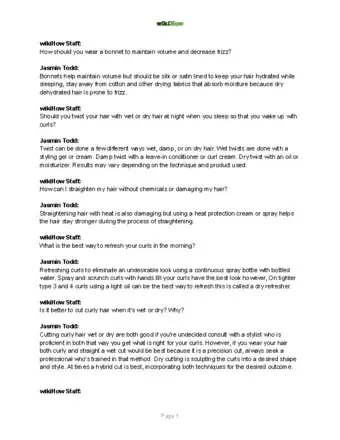
Thanks for reading our article! If you'd like to learn more about taking care of your hair, check out our in-depth interview with Jasmin Todd.
References
About This Article
To care for biracial hair, use a mild, moisturizing shampoo to avoid drying out your hair's natural oils. You should also use instant conditioner if you have thick, curly hair, as this will give it body and shine. Also, only wash your hair with shampoo every seven to ten days to avoid dryness, brittleness, and damage from overwashing. However, if you workout or sweat often, you can rinse your hair more often with just water. Additionally, blot your hair dry with a towel as rubbing it can cause frizziness and breakage. For more tips, including how to style biracial hair, read on!
-Hair-Step-1-Version-2.webp)
-Hair-Step-2-Version-2.webp)
-Hair-Step-3-Version-2.webp)
-Hair-Step-4-Version-2.webp)
-Hair-Step-5-Version-2.webp)
-Hair-Step-6-Version-2.webp)
-Hair-Step-7-Version-2.webp)
-Hair-Step-8-Version-2.webp)
-Hair-Step-9.webp)
-Hair-Step-10.webp)
-Hair-Step-11.webp)
-Hair-Step-12.webp)
-Hair-Step-13.webp)
-Hair-Step-14.webp)
-Hair-Step-15.webp)
-Hair-Step-16.webp)
-Hair-Step-17.webp)
-Hair-Step-18.webp)
-Hair-Step-19.webp)
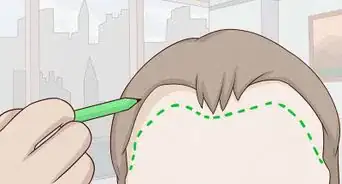
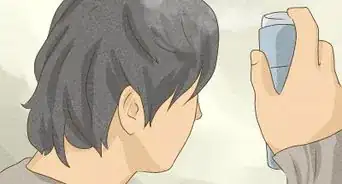

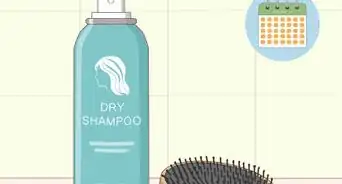
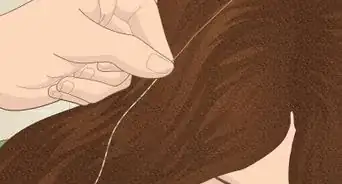

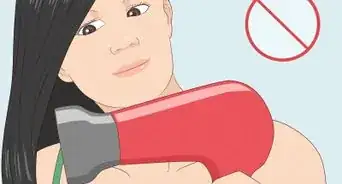
-Step-1-Version-8.webp)
